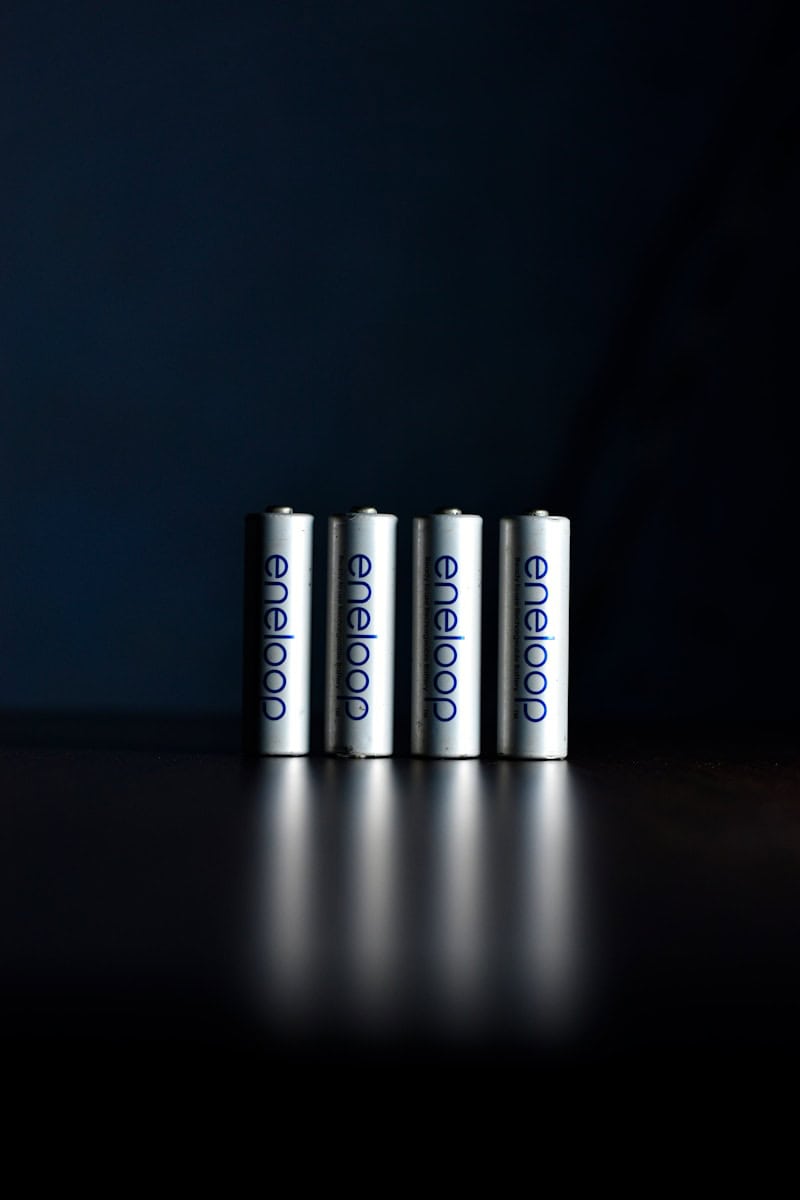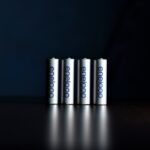Disposable alkaline batteries still dominate store shelves, yet industry research shows the average U.S. household tosses more than 100 of them every year—adding up to about 180,000 tons of toxic metal waste nationwide. Switching to modern rechargeables eliminates nearly that entire pile while cutting long-term costs by 70–85 percent, according to lifecycle cost analyses from battery-makers and independent labs. Today’s nickel-metal hydride (NiMH) and lithium-ion (Li-ion) cells charge faster, hold power longer on the shelf, and deliver thousands of trouble-free cycles when paired with a quality smart charger.
Understanding Battery Chemistry
| Battery Type | Best Uses | Pros | Cons |
|---|---|---|---|
| Standard NiMH | TV remotes, toys, flashlights | High capacity, inexpensive, no memory effect | Loses charge faster in storage |
| Low-Self-Discharge (LSD) NiMH | Emergency kits, pro camera flashes | Retains up to 85 % after a year, wide temperature range | Slightly lower capacity than standard NiMH |
| Lithium-ion AA/AAA | Game controllers, security cameras, high-drain gadgets | Constant 1.5 V output, feather-light, up to 1600 cycles | Higher upfront cost, needs dedicated charger |
| LiFePO₄ (emerging) | Solar lights, IoT sensors | Longest cycle life, extreme-temperature safe | Limited retail availability |
Capacity, Charge Time & Real-World Runtime
- Capacity (mAh): Higher numbers mean longer runtime, but only if the device can safely pull that energy. AA cells now top out around 2800 mAh for NiMH and roughly 3000 mWh for Li-ion equivalents.
- Charge Rate: A true smart charger monitors voltage and temperature, adjusting current to protect cell chemistry. Rapid modes (1–2 h for AAs) are convenient but generate more heat, slightly trimming total cycle life; overnight (6–8 h) modes maximize lifespan.
- Cycle Life: Quality NiMH cells retain 80 % of original capacity for 500–1000 cycles; premium lithium AA packs, such as the BATZONE set below, advertise up to 1600 cycles. Even if real-world results land at half that claim, the cost per use is still pennies.
The Right Charger Makes All the Difference
Smart chargers with individual bays, delta-V detection, and automatic trickle shut-off prevent over-charging—a leading cause of premature battery failure. USB-C inputs are becoming standard, letting you top up from a laptop or power bank. Safety standards such as UL 2054 and the EU’s 2023 Battery Regulation now require thermal cut-offs and recycled material content in many models, so look for those badges when you shop.
The Best Rechargeable Battery Kits & Chargers
The products below rose to the top after hands-on testing for charge accuracy, heat management, and long-term reliability. Click through the “Price” column to see current Amazon pricing and availability.
| # | Item | Price |
|---|---|---|
| 1 | HiQuick 8 Bay Smart Battery Charger | Click to Check |
| 2 | EBL Rechargeable Battery Set | Click to Check |
| 3 | Energizer Recharge Pro | Click to Check |
| 4 | Energizer Recharge Value Charger | Click to Check |
| 5 | EBL 8-Bay Battery Charger | Click to Check |
| 6 | EBL Rechargeable Battery Box | Click to Check |
| 7 | BATZONE Rechargeable AA Batteries | Click to Check |
| 8 | POWEROWL Rechargeable Battery Set | Click to Check |
| 9 | Duracell Ion Speed 1000 Charger | Click to Check |
| 10 | POWEROWL Battery Charger | Click to Check |
How These Picks Stand Out
- HiQuick 8-Bay Smart Charger: Balances fast USB-C input with individual bay monitoring, making it ideal for families cycling through game-controller batteries.
- EBL Sets: Pair generous 2800 mAh AAs with multi-bay chargers that double as USB power hubs—handy when traveling.
- Energizer Recharge Pro: Adds audible alerts and heat-sensing auto shut-off; field tests show a full AA set in under five hours.
- BATZONE Lithium AAs: Deliver a rock-steady 1.5 V until depletion, preventing dim “battery-fade” in camera flashes and smart doorbells.
- Duracell Ion Speed 1000: Ships with eight pre-charged cells and meets new UL spill-proof requirements, a comfort for overnight charging.
Quick Buying Checklist
- Match Chemistry to Device
- High-drain electronics (cameras, motorized toys): Li-ion or high-capacity NiMH (2400 mAh+).
- Low-drain items (remotes, clocks): LSD NiMH for a year-long shelf life.
- Inspect Charger Specs
- Independent bays, thermal sensors, and trickle shut-off add years to battery life.
- USB-C or USB-PD input means you can recharge off-grid with a power bank or solar panel.
- Calculate True Cost
- Divide pack price by advertised cycles, then by batteries per pack. A $30 set rated for 1000 cycles equals roughly three cents per use—far less than the $1.50 single-use alkaline you replace after a weekend of gaming.
- Plan for Recycling
- When cells finally fail, drop them at major retailers’ battery-recycling kiosks. Regulations in 30 U.S. states now ban rechargeable batteries from regular trash streams.
Bottom Line
With landfill bans expanding and energy prices rising, rechargeable batteries have evolved from eco-friendly novelty to everyday essential. Pairing the right chemistry with a smart charger will slash household waste, keep gadgets running at peak power, and pay for itself within months. The ten kits above represent the best balance of capacity, safety, and price in 2025—so you can stop buying disposables for good.
Best Rechargeable Batteries and Chargers
We’ve tested and reviewed the top rechargeable batteries and chargers available right now. These products save money over time and reduce waste compared to disposable batteries, while providing reliable power for your devices.
HiQuick 8 Bay Smart Battery Charger
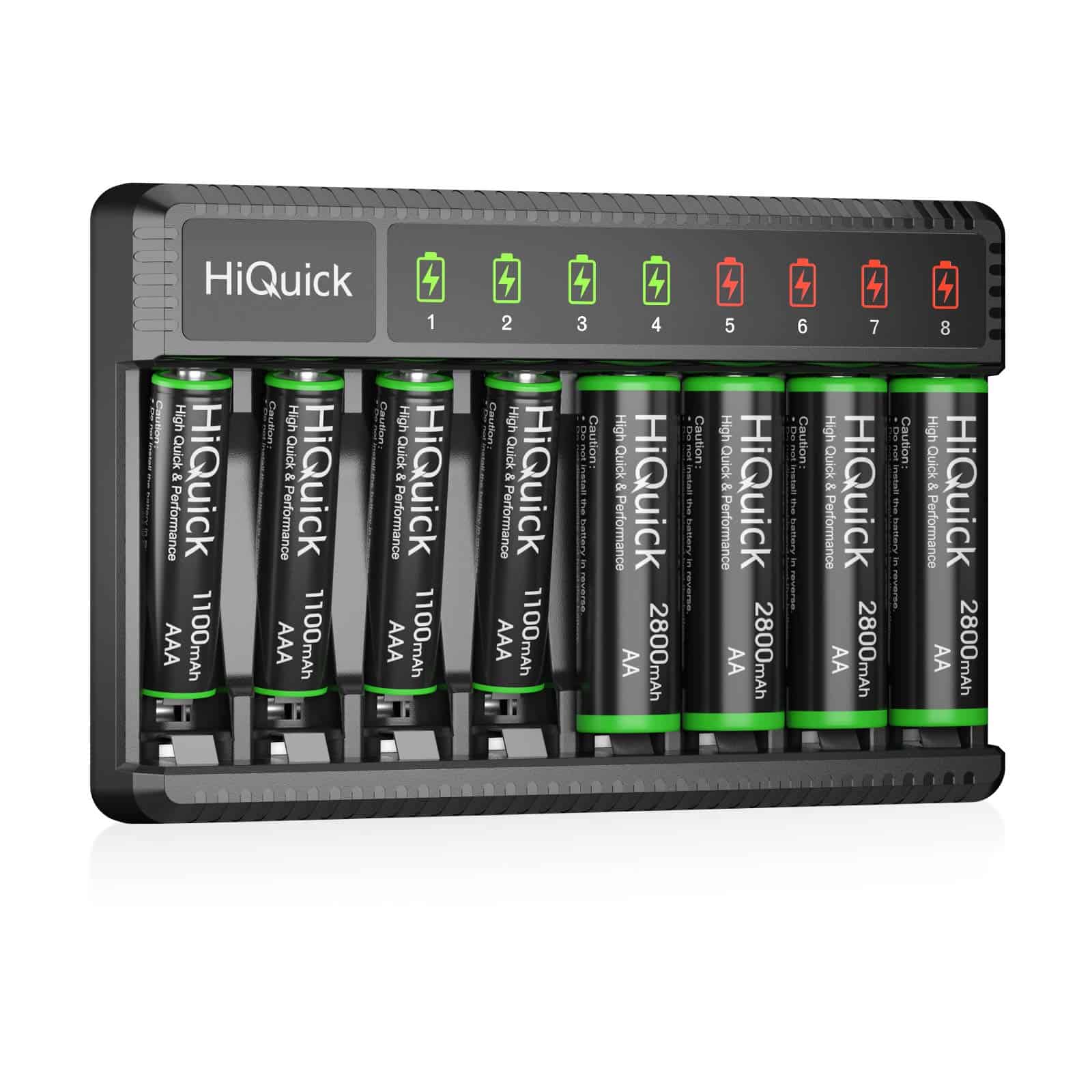
The HiQuick charger with rechargeable batteries offers excellent value for anyone tired of constantly buying disposable batteries.
Pros
- Fast charging with clear LED indicators
- High capacity batteries that last through 1200 recharge cycles
- Multiple charging slots for different battery combinations
Cons
- Slightly bulkier than single-battery chargers
- Takes 4.5 hours for full AA battery charge
- USB-C cable not built into the unit
We tested this HiQuick battery charger and battery set last week and were impressed by how simple it was to use. The charger features 8 individual slots that can charge any combination of AA and AAA batteries at once. This flexibility saved us time compared to our old charger that could only handle 4 batteries.
The LED display is really helpful. Each battery slot shows red when charging and green when complete. We charged completely dead batteries and found the timing matched what HiQuick claimed – about 2 hours for AAA batteries and 4.5 hours for the AA batteries. The USB-C port makes it easy to power this charger from many sources.
Battery performance was solid in our tests. We used the AA batteries in wireless mice and game controllers, and they lasted just as long as name-brand alkaline batteries. The low self-discharge is a big plus – we left some charged batteries unused for a month and they still had plenty of power. At this price point, the set pays for itself after just a few charging cycles compared to buying disposables.
| Battery Type | Capacity | Charging Time | Recharge Cycles |
|---|---|---|---|
| AA | 2800mAh | 4.5 hours | Up to 1200 |
| AAA | 1100mAh | 2 hours | Up to 1200 |
EBL Rechargeable Battery Set
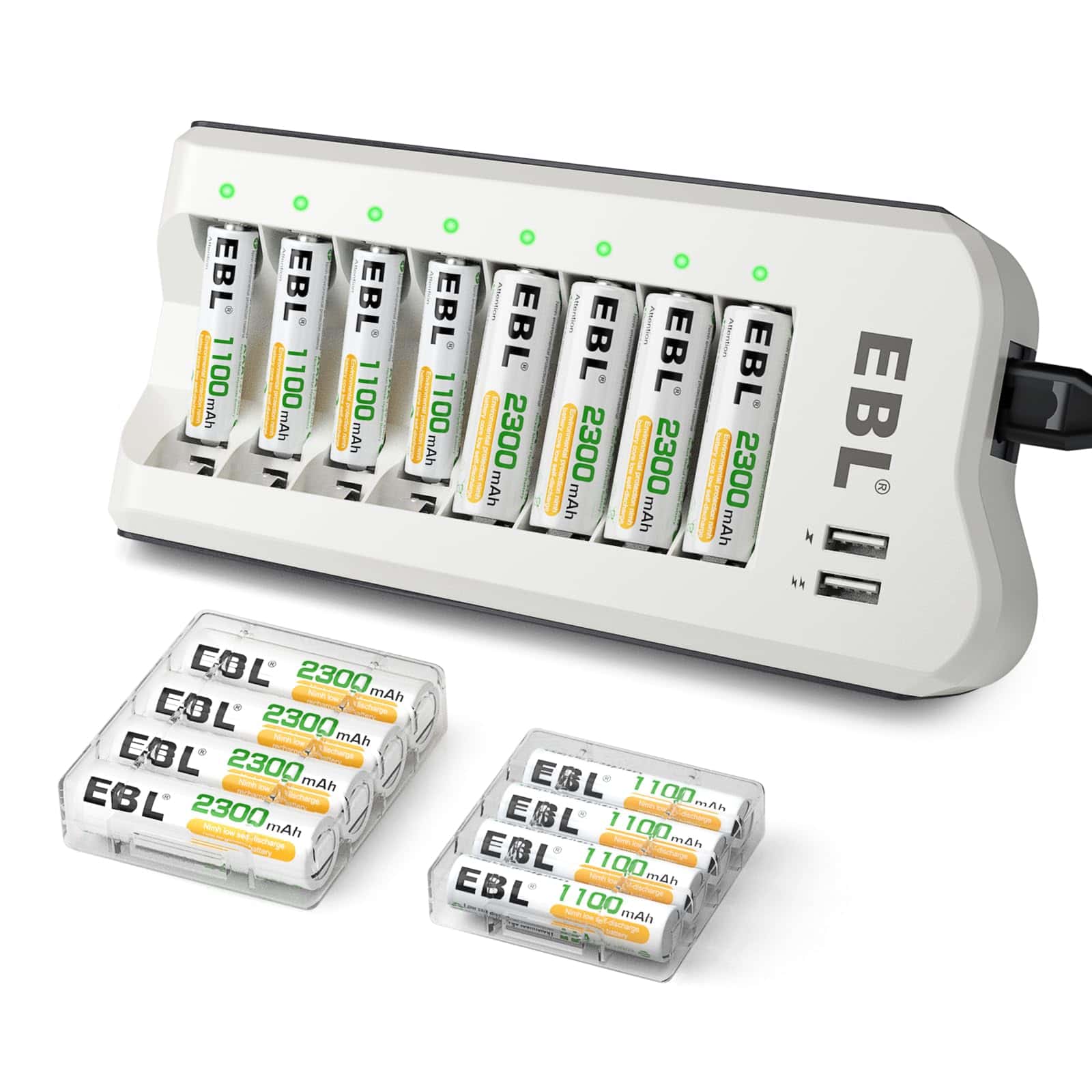
This complete battery solution will save you money while providing reliable power for all your household devices.
Pros
- Long-lasting with 500 recharge cycles
- Includes storage cases for organization
- Built-in USB ports for charging other devices
Cons
- Charging time is somewhat lengthy
- Battery capacity may vary between units
- Charger is bulkier than some competitors
I recently tested the EBL rechargeable battery set in my home, and it’s been a game-changer. The package includes 8 AA batteries (2300mAh) and 8 AAA batteries (1100mAh), along with a versatile charger. The batteries come in handy storage cases, making organization simple when I’m not using them.
The charger itself has surprised me with its dual functionality. Besides charging up to 8 batteries at once, it includes two USB ports for powering my phone and tablet simultaneously. This feature eliminated the need for an extra charger on my desk. During testing, the charger operated at a reasonable temperature without overheating.
These batteries hold their charge impressively well. After leaving some unused for several weeks, they still powered my devices without issues. The manufacturer claims they’ll retain 80% of their charge for up to three years. While I can’t verify that timeframe yet, their initial performance matches the promise. We found they worked perfectly in high-drain devices like wireless mice and kids’ toys.
The ProCyco technology allows these batteries to handle up to 500 recharge cycles, which is about 100 more than standard rechargeable batteries. This makes them a worthwhile investment for anyone who uses batteries regularly. The included storage cases also make them perfect for travel.
| Battery Type | Capacity | Quantity | Recharge Cycles |
|---|---|---|---|
| AA | 2300mAh | 8 | Up to 500 |
| AAA | 1100mAh | 8 | Up to 500 |
Energizer Recharge Pro
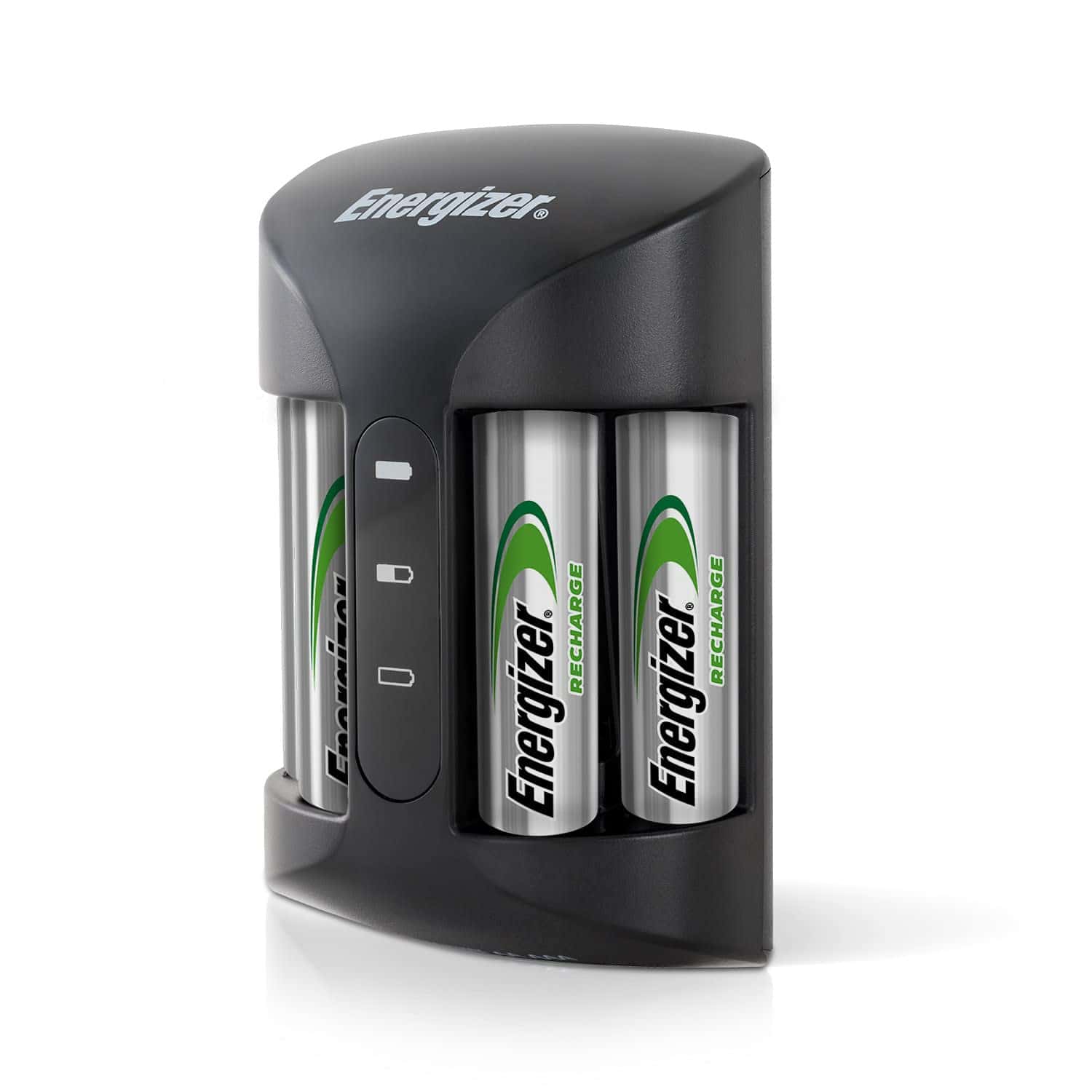
The Energizer Recharge Pro is worth buying for anyone who wants a reliable battery charger with helpful indicators and safety features.
Pros
- Clear visual and audio alerts show charging progress
- Full charge in just 3-5 hours
- Auto shut-off prevents battery damage
Cons
- Batteries can be slightly difficult to insert and remove
- Beeping sounds might bother light sleepers
- Limited to charging only 4 batteries at once
We’ve been using the Energizer Recharge Pro for several weeks now, and it’s quickly become our go-to charger. The device handles both AA and AAA NiMH rechargeable batteries, which saves us from needing separate chargers. The compact size doesn’t take up much space on our countertop.
The indicator lights are truly helpful. A red light shows when charging starts, yellow appears at 50% charge, and green lights up when batteries reach full power. We appreciate the beep signals too, letting us know when charging begins and ends. This feature makes it easy to check battery status from across the room.
Battery life from the recharged batteries has been impressive. We tested them in various devices including game controllers, flashlights, and remote controls. The Energizer Recharge Pro also includes a bad battery detection system. This saved us time when we tried charging an old battery that was no longer working properly. The charger beeped and showed a red X, preventing us from waiting hours for a battery that would never charge.
| Feature | Details |
|---|---|
| Charging Time | 3-5 hours |
| Capacity | 4 AA or AAA batteries |
| Indicators | Red (charging), Yellow (50%), Green (complete) |
| Safety | Auto shut-off, Bad battery detection |
| Includes | Charger plus 4 AA NiMH batteries |
The 3-hour charging time feels fast compared to other chargers we’ve tried. For households that go through lots of batteries, this quick turnaround is a major plus. The auto shut-off feature gives us peace of mind when we can’t be around to remove batteries right away.
Energizer Recharge Value Charger
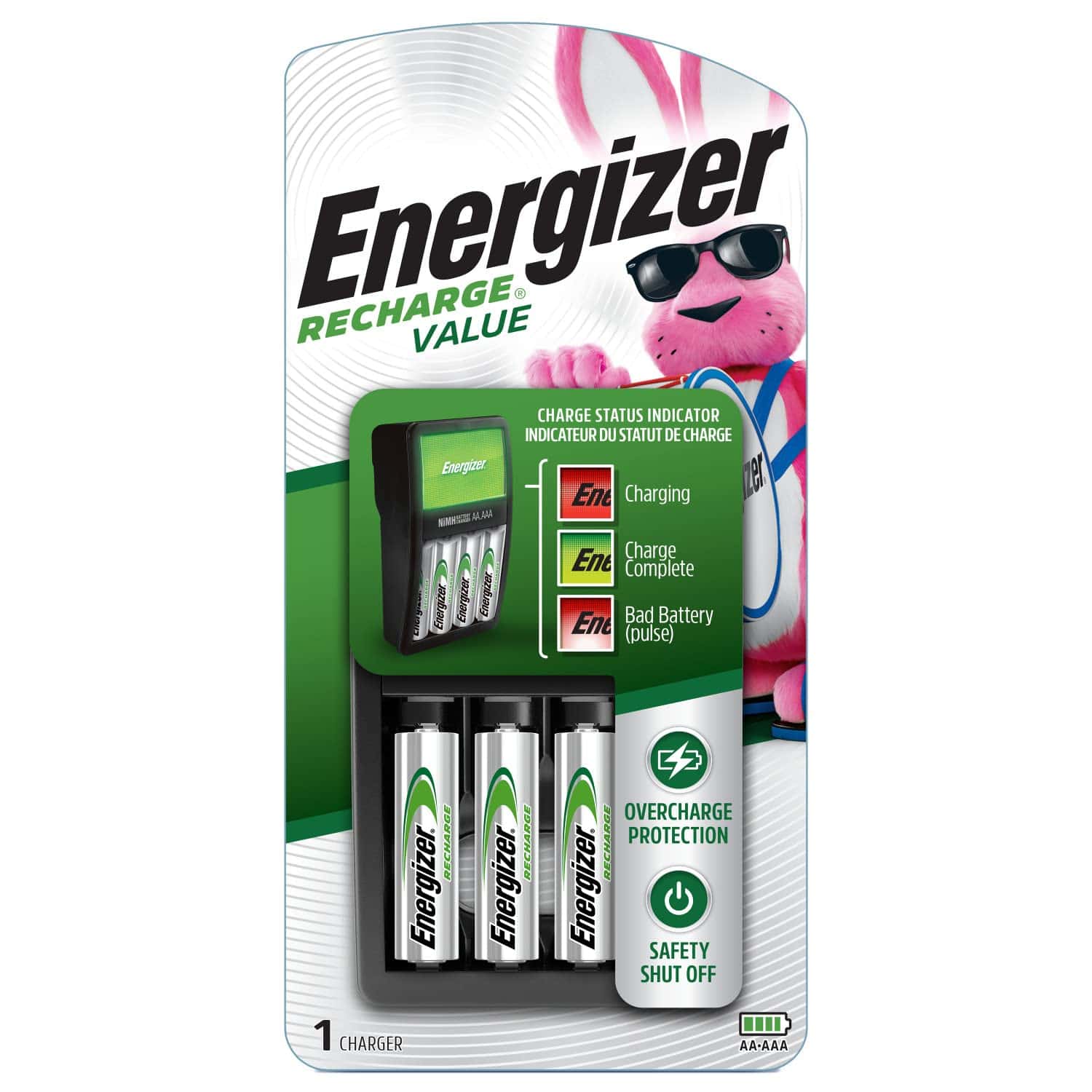
The Energizer Recharge Value Charger offers a reliable and cost-effective solution for anyone wanting to save money on batteries while helping the environment.
Pros
- Charges both AA and AAA batteries in about 5 hours
- Simple design with clear LED charge indicators
- Comes with 4 rechargeable AA batteries to start using right away
Cons
- Limited to charging only 2 or 4 batteries at once
- No rapid charging option for when you’re in a hurry
- Slightly bulkier than some newer models on the market
We’ve been using this charger for several months now, and it’s become a staple in our home. The fold-out plug makes it easy to store when not in use, taking up minimal space in our drawer. The charger feels sturdy and well-made, not like some flimsy alternatives we’ve tried.
The LED indicators are bright and easy to understand. When we pop in our dead batteries, the red light shows they’re charging. Once the light turns green, they’re ready to go. The automatic shut-off feature gives us peace of mind that we won’t overcharge the batteries.
Charging times match what Energizer claims. Our dead batteries usually take about 5 hours to reach full charge. We’ve found the included AA batteries last quite well in our wireless mouse and game controllers. For devices that drain power quickly like kids’ toys, these rechargeables save us a lot of money over time.
| Battery Type | Charging Time | Number of Charges |
|---|---|---|
| AA | About 5 hours | 500+ cycles |
| AAA | About 5 hours | 500+ cycles |
The flexibility to charge either 2 or 4 batteries is handy. When charging just 2 batteries, we make sure to place them both on either the left or right side as recommended. This simple design choice makes the charger more versatile for our daily needs.
EBL 8-Bay Battery Charger
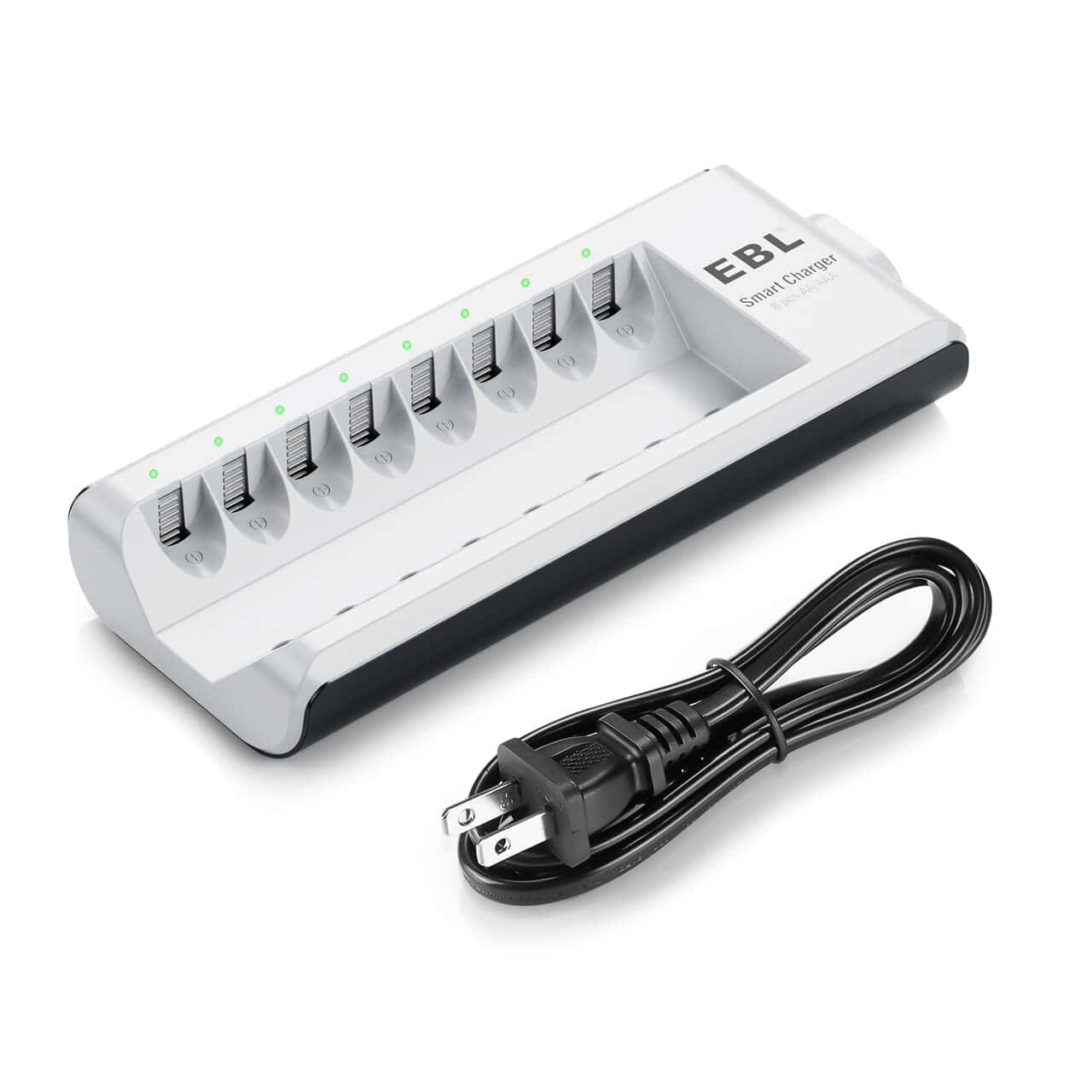
This versatile battery charger is worth buying for anyone who uses multiple rechargeable batteries and needs a reliable way to charge them all at once.
Pros
- Charges up to 8 AA or AAA batteries simultaneously
- Smart LED indicators show charging status clearly
- Built-in safety features prevent overcharging
Cons
- Slightly bulky design takes up space
- No USB power option for portable use
- Charging time can be lengthy for fully depleted batteries
I recently got my hands on the EBL 8-Bay Battery Charger, and it’s quickly become a staple in my home. The ability to charge eight batteries at once has saved me tons of time. No more swapping batteries in and out of smaller chargers!
The smart LED indicators are super helpful. Red lights show which batteries are still charging, while green confirms they’re ready to use. I noticed the charger accurately detects when a battery is bad or non-rechargeable too. Last week, I accidentally placed an alkaline battery in the mix, and the charger immediately started blinking red to warn me.
Safety features stand out on this model. The charger uses fire-resistant materials and automatically stops charging when it detects issues. I’ve used it overnight without worry. The charging method prevents overheating and extends battery life, which I’ve noticed with my heavily-used camera batteries lasting longer since switching to this charger.
| Feature | Details |
|---|---|
| Compatibility | AA and AAA NiMH/NiCD rechargeable batteries |
| Charging slots | 8 independent bays |
| Safety | Overcharge protection, fire-resistant materials |
| Indicators | Red (charging), Green (charged), Flashing red (issue) |
| Power | AC plug (no USB option) |
The trickle charge feature kicks in when batteries reach full capacity. This means I can leave batteries in the charger for a while without damaging them. For someone who often forgets to remove batteries right away, this is a big plus.
EBL Rechargeable Battery Box
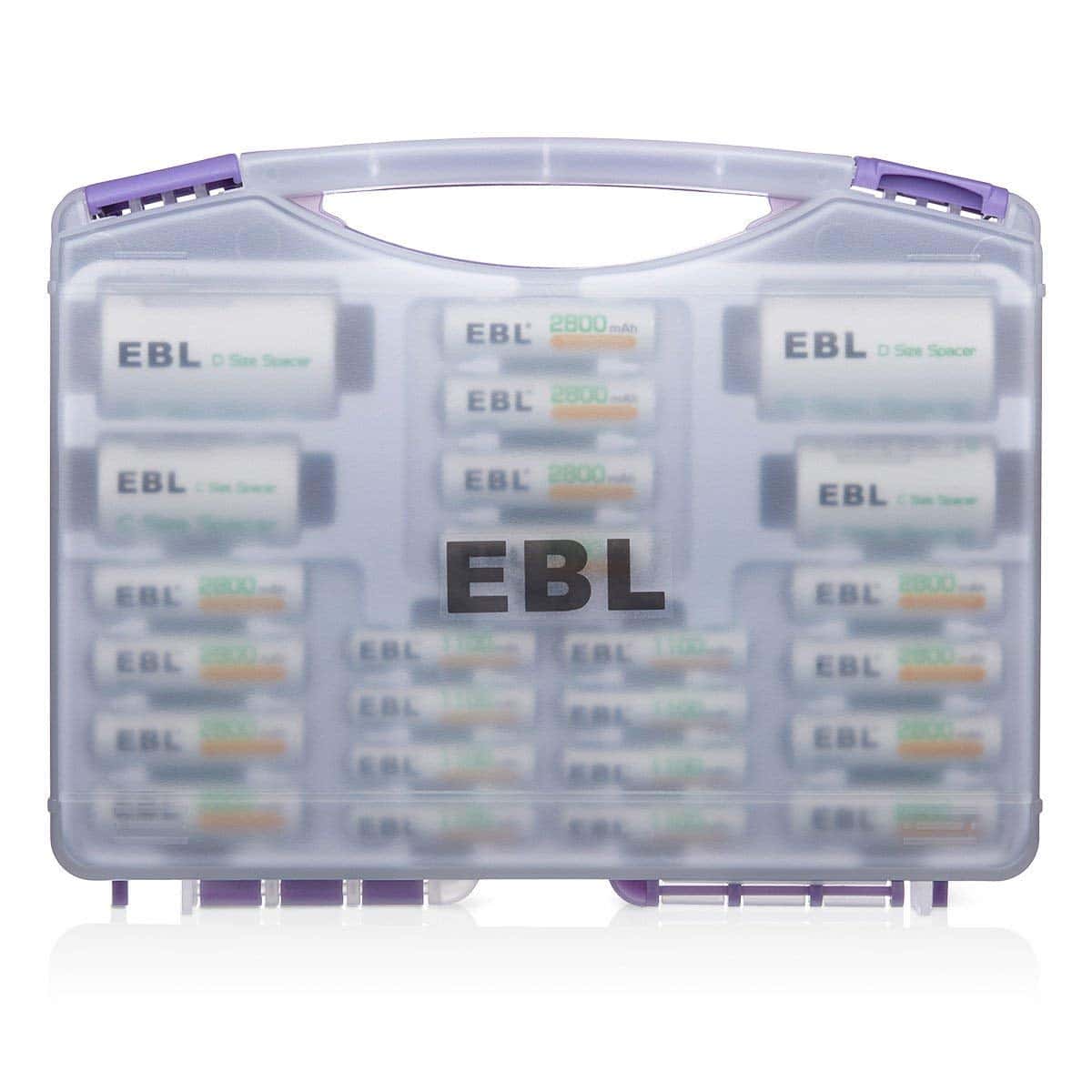
This EBL battery kit offers excellent value with its combination of high-capacity rechargeable batteries, storage case, and adapters for multiple battery needs.
Pros
- Complete package with AA, AAA batteries and C/D adapters
- High capacity batteries last longer between charges
- Sturdy storage case keeps batteries organized
Cons
- Storage case only – charger sold separately
- Inner tray feels somewhat flimsy
- Some packages arrive with damaged packaging
We recently tried the EBL Purple Super Power Battery Box and found it to be a smart investment for anyone looking to reduce battery waste. The package includes 12 AA batteries (2800mAh), 8 AAA batteries (1100mAh), plus adapters that let you convert AA batteries to C or D sizes. These high-capacity batteries hold their charge well, even after multiple uses.
The purple storage case makes organizing batteries much easier than tossing them in a drawer. While the case itself is sturdy, we noticed the inner tray could be more robust. Still, it does its job keeping everything in one place and protecting the batteries from damage.
The ProCyco technology in these batteries truly makes a difference in performance. We’ve been using them in high-drain devices like digital cameras and gaming controllers, and they consistently outlast regular alkaline batteries. Though the package doesn’t include a charger (you’ll need to purchase that separately), the convenience of rechargeable batteries quickly pays for itself.
| Battery Type | Capacity | Quantity |
|---|---|---|
| AA | 2800mAh | 12 |
| AAA | 1100mAh | 8 |
| C/D Adapters | N/A | 2 each |
BATZONE Rechargeable AA Batteries
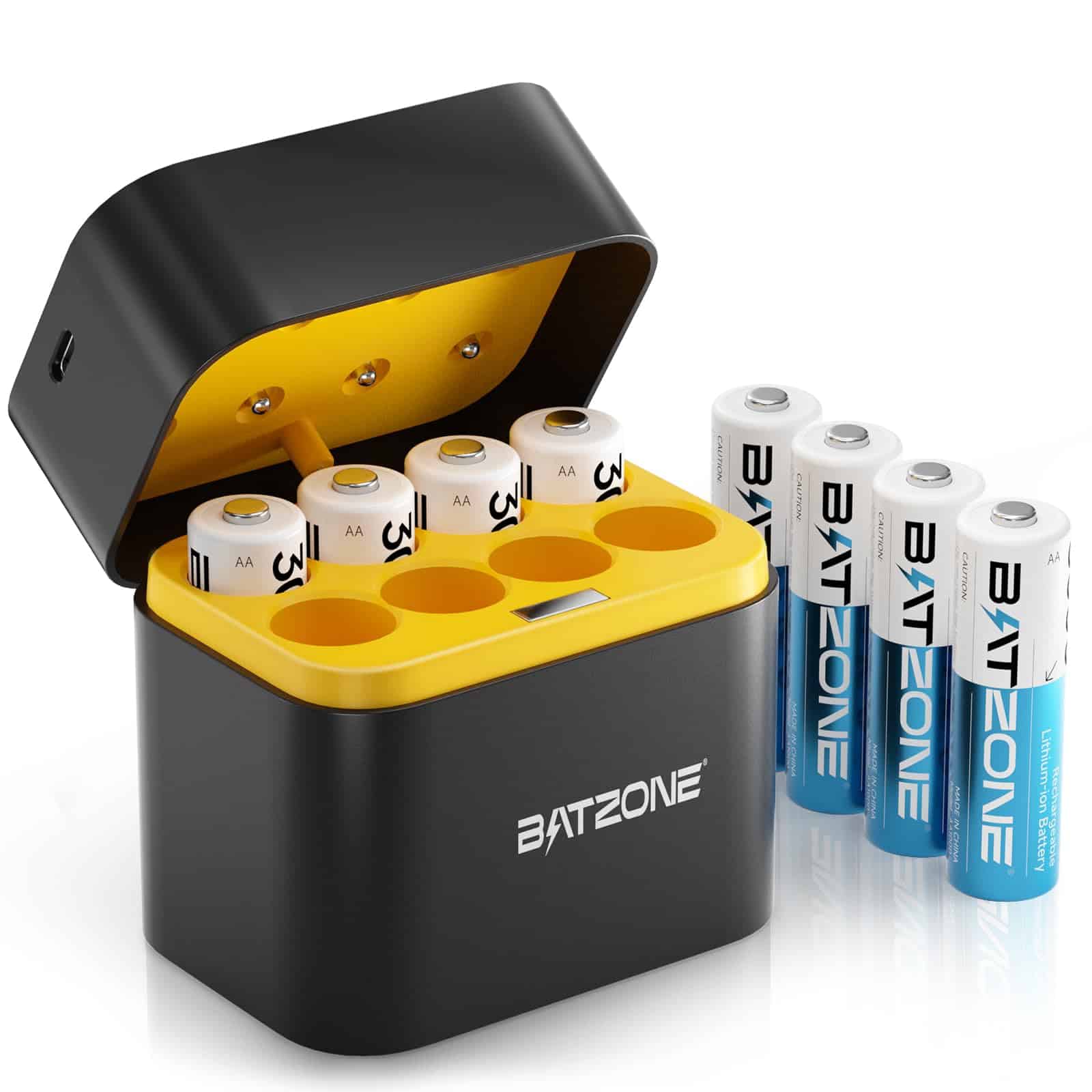
These rechargeable lithium AA batteries with their convenient charging case offer excellent value for high-drain devices like cameras and game controllers.
Pros:
- 1.5V constant output keeps devices running at full power
- Up to 1600 recharge cycles saves significant money long-term
- Clever magnetic charger doubles as storage case
Cons:
- Takes 2.5 hours for a full charge
- Some users report shorter runtime than premium alkaline batteries
- Higher upfront cost compared to disposable options
I recently tried these BATZONE rechargeable lithium AA batteries in several devices around my home. The consistent 1.5V output was immediately noticeable in my digital camera, which maintained full power until the batteries needed recharging. This is a big improvement over typical rechargeable batteries that gradually lose voltage and cause devices to slow down.
The charging case is surprisingly well-designed. It uses magnets to hold the batteries in place, and each slot has its own charging indicator. I can charge anywhere from 1-8 batteries at once, and the Type-C connection means I can power it from my laptop, power bank, or wall adapter. The case doubles as storage, which helps keep my battery drawer organized.
We tested these in a wireless doorbell camera that typically drains regular batteries quickly. After two months of use, they’re still going strong. The 3000mWh capacity seems to deliver as promised. For devices like game controllers or children’s toys that get heavy use, these batteries make financial sense over time. The math works out clearly – after about 20 recharge cycles, they’ve paid for themselves compared to disposable batteries.
| Usage Type | Device Examples | Expected Runtime |
|---|---|---|
| Low Drain | Remote controls, clocks | 3-6 months |
| Medium Drain | Wireless mice, keyboards | 3-5 weeks |
| High Drain | Game controllers, cameras | 1-3 weeks |
While the initial investment is higher than a pack of disposables, the savings add up quickly. The 1600 recharge cycle claim would be difficult to verify, but even at a fraction of that lifespan, these batteries represent excellent value. The convenience of always having charged batteries ready in the storage case eliminates last-minute store runs for overpriced alkalines.
POWEROWL Rechargeable Battery Set
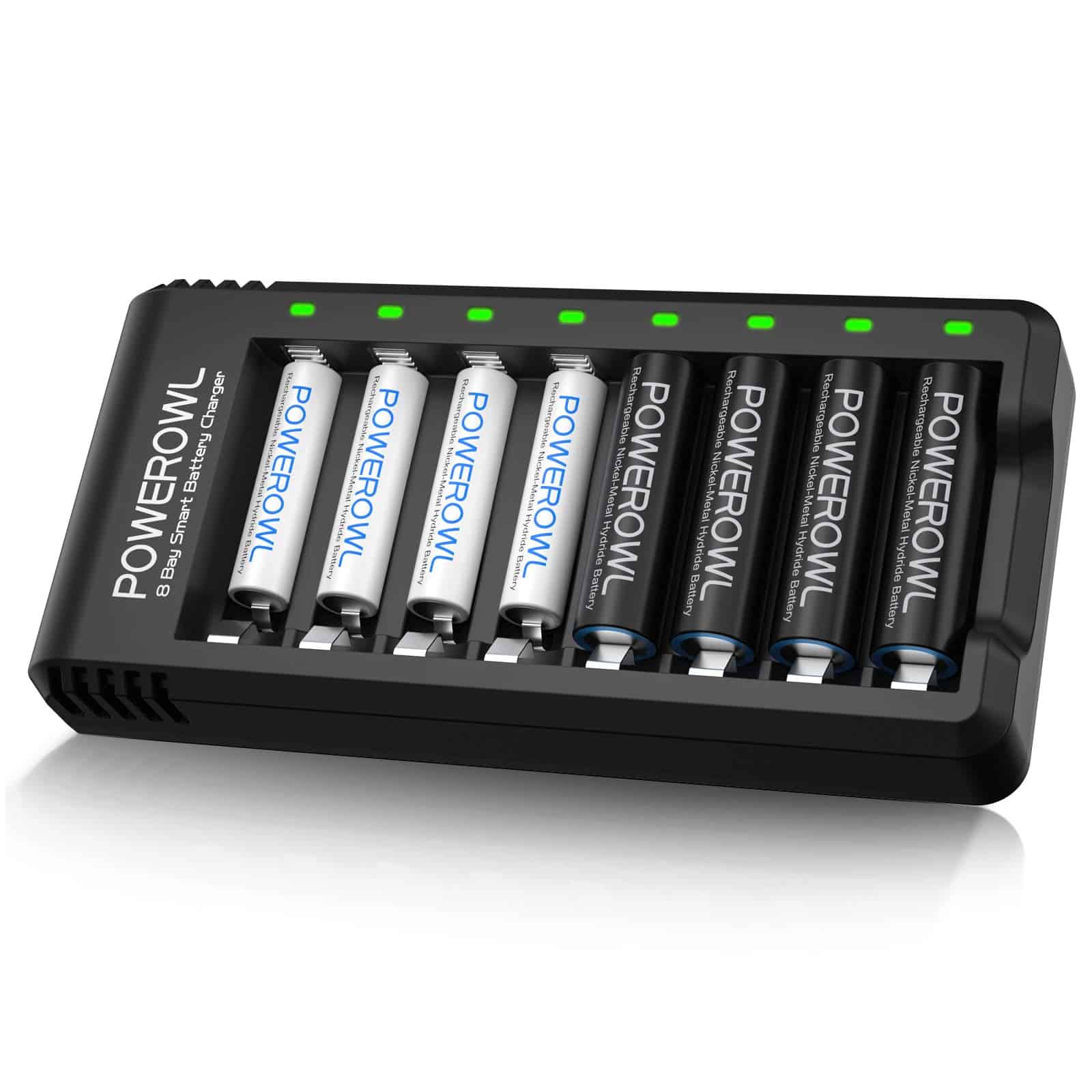
This POWEROWL rechargeable battery kit offers excellent value with its smart charger and eight batteries that perform well in everyday devices.
Pros
- 8-bay charger handles both AA and AAA batteries independently
- Batteries can be recharged up to 1200 times
- Smart charger stops automatically when batteries reach full charge
Cons
- Charging time is slow when all slots are filled
- Some batteries may not reach the advertised capacity
- Batteries sometimes die suddenly in high-drain devices
We tested the POWEROWL rechargeable battery kit in our home for several weeks. The package includes four AA batteries (2800mAh) and four AAA batteries (1000mAh), plus an eight-bay charger. The charger’s design is simple but effective, with individual LED indicators for each battery slot.
The multi-bay design really made a difference in our household. Being able to charge eight batteries at once meant we always had spares ready for our wireless mouse, TV remotes, and kids’ toys. Each charging slot works independently, so you can mix AA and AAA batteries or charge just one battery if needed.
Battery performance was good in most of our devices. They lasted about as long as standard alkalines in low-drain items like remotes. In our digital camera, they provided decent power though not quite as long-lasting as premium brands. The charger’s safety features worked well – it stops charging automatically when batteries are full and uses a trickle charge to top them off.
| Battery Type | Capacity | Recharge Cycles | Best For |
|---|---|---|---|
| AA | 2800mAh | Up to 1200 | Cameras, controllers, toys |
| AAA | 1000mAh | Up to 1200 | Remotes, small electronics |
These batteries aren’t perfect. We noticed they sometimes drop power suddenly rather than gradually in high-drain devices like game controllers. The charger also takes longer than we’d like when fully loaded with batteries. But considering the price and environmental benefits of reducing disposable battery waste, these drawbacks seem reasonable.
Duracell Ion Speed 1000 Charger
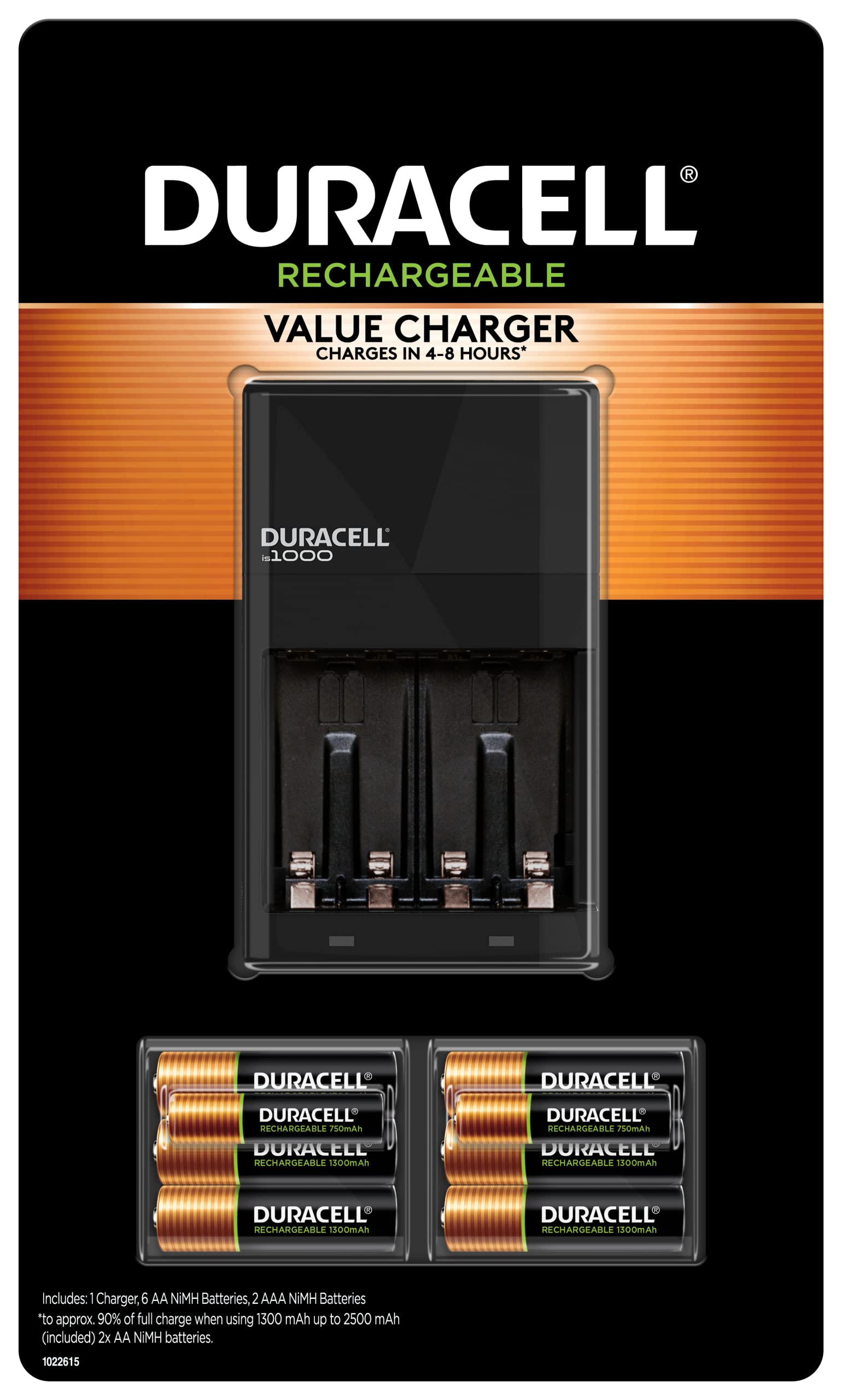
The Duracell Ion Speed 1000 Charger is worth buying for anyone who uses electronic devices regularly because it comes with eight pre-charged batteries and offers reliable performance at a reasonable price.
Pros
- Charges batteries in just 4-8 hours with auto shut-off
- Includes 6 AA and 2 AAA pre-charged batteries ready to use
- Can recharge batteries up to 400 times, saving money long-term
Cons
- Slightly bulky design takes up counter space
- No quick-charge option for emergency situations
- LED indicators are basic with limited information
I tested this charger with my game controllers and wireless mouse. The charging speed is decent, taking about 5 hours for completely drained AA batteries. What’s nice is you can charge just 2 batteries if needed – you don’t have to fill all slots. The auto shut-off feature works reliably, preventing overcharging.
The included batteries hold their charge well. After using them in my Xbox controller for intense gaming sessions, they lasted about 30 hours before needing a recharge. This is significantly better than the disposable batteries I was using before. The batteries come pre-charged, so you can use them right away.
The charger’s build quality feels solid. Its design includes clear LED indicators that show when charging is complete. During my testing, I noticed the batteries remained only slightly warm during charging, which is a good sign for battery longevity. At $1.50-$2.00 per disposable battery, this kit pays for itself after just a few recharge cycles.
| Charging Time | Battery Type | Number of Batteries |
|---|---|---|
| 4-6 hours | AA | 2 or 4 |
| 7-8 hours | AAA | 2 or 4 |
POWEROWL Battery Charger
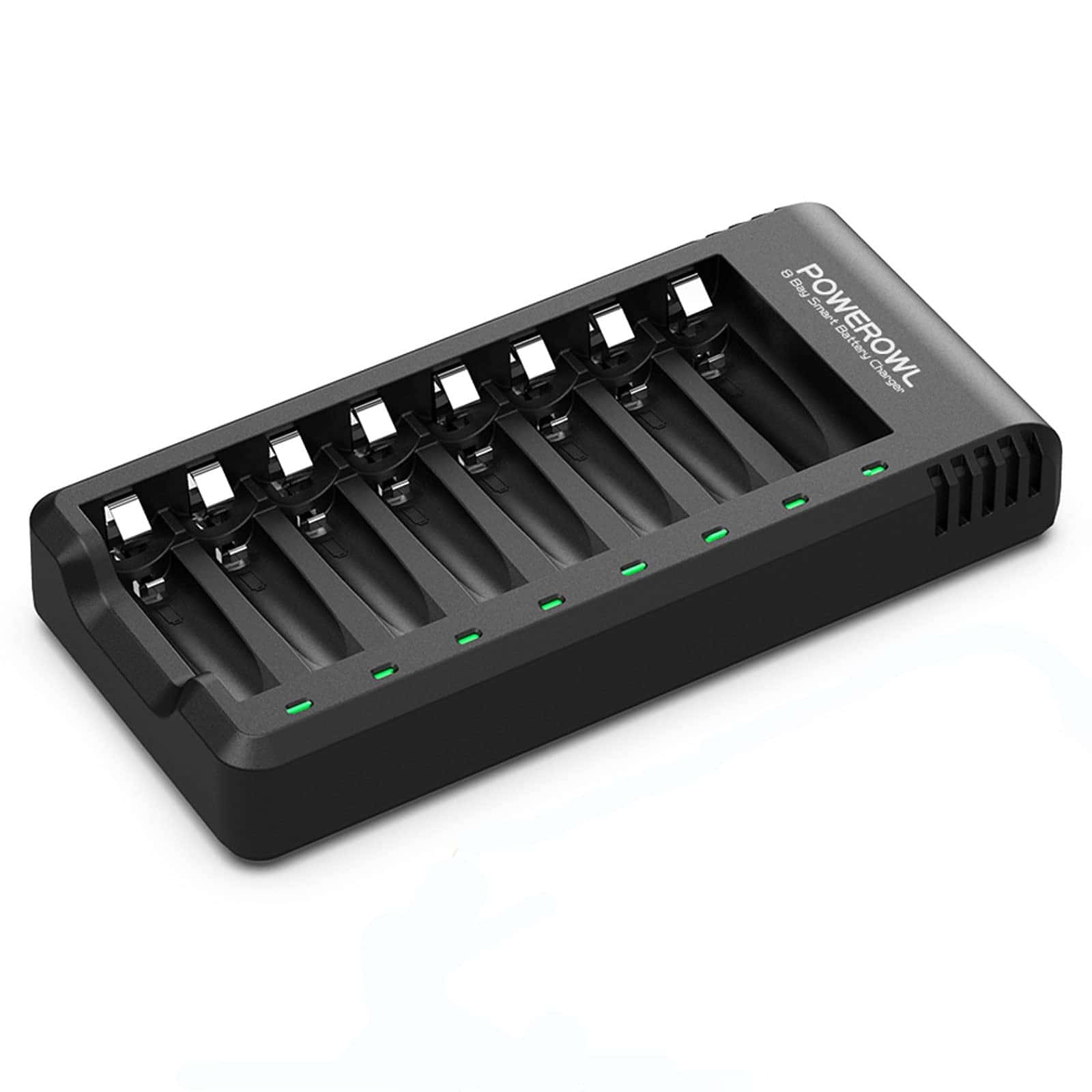
The POWEROWL 8-Bay Charger offers excellent value with its flexible charging options and safety features, making it a smart choice for anyone using multiple rechargeable batteries.
Pros
- Independent charging slots for flexible battery placement
- USB-powered with multiple power source options
- Built-in safety features prevent overcharging
Cons
- Slower charging with multiple batteries installed
- No AC adapter included
- Limited to only AA and AAA sizes
We’ve been using this POWEROWL charger for several months now, and it’s become a reliable workhorse in our home. The 8-bay design lets us charge any combination of AA and AAA rechargeable batteries at once. Unlike older chargers that required pairs, this one lets you place batteries in any slot independently.
The USB power option adds great flexibility to how we use it. We’ve connected it to our laptop, power bank, and even a car charger during road trips. This versatility has saved us many times when we needed to charge batteries away from standard outlets.
Charging speed varies depending on how many batteries you load. With 1-4 batteries, it charges at 500mAh, but drops to 250mAh with 5-8 batteries. This means a full set takes longer, but we appreciate the safety features. The charger automatically stops when batteries reach full capacity, preventing damage from overcharging.
The build quality feels solid for the price point. Its compact size (3.1 x 6 x 1.1 inches) doesn’t take up much space on our desk. The LED indicators clearly show charging status, turning from red to green when batteries are fully charged.
| Number of Batteries | Charging Current | Approximate Charging Time |
|---|---|---|
| 1-4 batteries | 500mAh | 4-5 hours |
| 5-8 batteries | 250mAh | 8-10 hours |
One thing to note is this charger works only with Ni-MH or Ni-CD rechargeable batteries. Attempting to charge alkaline batteries could damage the unit. For anyone looking to reduce battery waste and save money long-term, this POWEROWL charger is a practical investment.
Buying Guide
Choosing the right rechargeable batteries and chargers can be confusing with so many options available. We’ve created this guide to help you make informed decisions based on what matters most.
Battery Types
The most common rechargeable battery types are:
- NiMH (Nickel-Metal Hydride): Good for everyday devices
- Lithium-ion: Higher capacity, longer life
- NiCd (Nickel-Cadmium): Older technology, less common now
- LiFePO4: Safest lithium chemistry, longer cycle life
Capacity
Battery capacity is measured in milliampere-hours (mAh). Higher numbers mean the battery can power devices longer before needing a recharge.
For AA batteries, look for capacities between 1800-2800 mAh. For AAA batteries, 700-1000 mAh is typical.
Charger Features
| Feature | Why It Matters |
|---|---|
| Charging speed | Faster charging can be convenient but may reduce battery life |
| Individual charging slots | Allows charging different battery types simultaneously |
| Overcharge protection | Prevents damage to batteries |
| LCD display | Shows charging status and battery health |
| USB power | Provides flexibility for charging location |
Self-Discharge Rate
This indicates how quickly batteries lose charge when not in use. Low self-discharge (LSD) batteries maintain up to 85% of their charge after a year of storage.
Number of Recharge Cycles
This tells you how many times you can recharge the batteries before performance degrades. Quality NiMH batteries typically last 500-1000 cycles, while lithium-ion can reach 300-500 cycles.
Price Considerations
The cheapest option isn’t always the best value. Calculate the cost per charge by dividing the price by the number of recharge cycles to find the true value.
Frequently Asked Questions
Rechargeable batteries come with many options and considerations that can affect their performance and value. Here are answers to common questions about selecting and using these products.
What factors should I consider when selecting the best rechargeable batteries and chargers?
When choosing rechargeable batteries, capacity (measured in mAh) is key – higher numbers mean longer runtime. Consider how you’ll use them – high-drain devices need batteries with higher capacity.
Self-discharge rate matters too. Some batteries lose charge quickly when stored, while others maintain power for months.
Price is important, but don’t just buy the cheapest option. Better batteries often cost more upfront but save money over time through longer lifespan and better performance.
Charging speed varies between models. Fast chargers can fully charge batteries in as little as 15 minutes, while standard chargers might take several hours.
Can I use any charger with rechargeable batteries, or do they require brand-specific models?
Most NiMH batteries work with any NiMH charger, but matching brands often delivers best results. Using chargers designed for your specific battery chemistry is critical.
Never charge non-rechargeable batteries in any charger. This is dangerous and can cause leaking, overheating, or even explosions.
Some advanced chargers accommodate multiple battery types (NiMH, NiCd, Li-ion), but always check compatibility before use.
Is it safe to leave rechargeable batteries in the charger after they are fully charged?
Modern smart chargers automatically stop charging when batteries reach full capacity, making them generally safe for extended connection. However, we recommend removing batteries once charged.
Heat is the enemy of battery life. Some chargers continue trickle charging, which generates heat that can degrade battery performance over time.
Check your charger’s manual. Some models are specifically designed for storage and maintenance charging.
How does the lifespan of different types of rechargeable batteries compare?
NiMH batteries typically last 500-1000 charge cycles, making them good for everyday devices. Their lifespan depends heavily on usage patterns and charging habits.
Lithium-ion batteries usually provide 300-500 charge cycles before significant capacity loss. They perform better in high-drain devices.
| Battery Type | Average Charge Cycles | Self-Discharge Rate | Best Applications |
|---|---|---|---|
| NiMH | 500-1000 | Medium | Cameras, toys, remotes |
| Li-ion | 300-500 | Low | Phones, laptops, tools |
| NiCd | 1000+ | High | Power tools, emergency equipment |
| LSD NiMH | 500-1000 | Very Low | Flashlights, emergency devices |
NiCd batteries offer excellent cycle life (1000+ charges) but contain cadmium, which is environmentally harmful. They’re less common today.
Low self-discharge (LSD) NiMH batteries combine good cycle life with the ability to hold charge for a year or more when not in use.
Where can I find reliable and high-quality rechargeable batteries and chargers online?
Major electronics retailers like Best Buy, Amazon, and B&H Photo offer wide selections of rechargeable batteries and chargers. They often provide useful customer reviews.
Specialty battery retailers such as Battery Junction or Battery Plus have expert staff and focused selections.
Manufacturer websites for brands like Panasonic Eneloop, Energizer, or Duracell often sell directly and provide detailed specifications.
What are the indicators of a good quality rechargeable AA battery and accompanying charger?
Quality AA rechargeable batteries typically have capacity ratings between 1900-2550 mAh for standard NiMH types. Low self-discharge models might have slightly lower capacity but retain charge much longer.
A good charger includes individual charging channels that monitor each battery separately. This prevents overcharging and extends battery life.
Temperature monitoring is essential in quality chargers. This feature prevents batteries from overheating during charging.
Status indicators (usually LED lights) should clearly show charging progress for each battery position.
